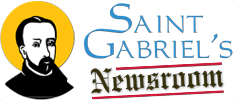Introduction to Liturgy
We often hear the word liturgy. It is frequently used interchangeably with Mass. It is true that all Masses are liturgies, but not all liturgies are Mass.
So, what does liturgy mean?
We often hear the word liturgy. It is frequently used interchangeably with Mass. It is true that all Masses are liturgies, but not all liturgies are Mass.
So, what does liturgy mean?
Liturgy is from a Greek word leitourgia meaning public work. Liturgy is God’s public work. During the liturgy of the Mass, He becomes present to us through the people collected as the Body of Christ, through the Word and the Eucharist, and through the priest when he acts “in persona Christi”. During a Liturgy of the Word or The Liturgy of the Hours (Divine Office, Breviary), God becomes present in the Word. In the sense that we actively participate in these as the collected Body of Christ, this becomes our work, too. To participate in any of these, one need only to be present and to enter into the prayer.
Some words on the Mass.
The word “Mass” comes from the Latin word mittere which means “to send”. It comes from the dismissal of the Extraordinary (old) Form of the Mass, which was said in Latin. For Roman Catholics, Mass may be said in either the Ordinary Form, which is usually said in the vernacular language, but which may contain Latin or Greek, or in the Extraordinary Form, which is generally said in Latin. The Extraordinary form may also be referred to as the Tridentine Mass, the Traditional Latin Mass or simply the old Mass.
The Mass is a dialogue. Throughout, God speaks to us through the priest. Sometimes the priest speaks to God on our behalf (the Collect), and sometimes we speak for ourselves, such as during the Creed, the Our Father, and the Great Amen.
If you look into the Roman Missal, you will notice that some parts are written in red and some in black. Very basically, the priest does the red and says the black. The priest can make his own choices of prayers for some parts of the Mass, such as at the Eucharistic Prayer, but a good portion of the Mass is intended to be the same everywhere.
The rules for this are in the General Instructions to the Roman Missal (GIRM). These instructions are found at the beginning of both the Lectionary (the book containing the readings used during Mass), and the Roman Missal. The GIRM tells us who does what and when. What is the proper role of the Deacon? The Celebrant? Concelebrants? The Congregation? When do we stand? When are we to be silent? Who may give a homily? These are some of the questions that are answered in the GIRM.
The GIRM has actually been revised over the past few years. The Editio Typica, the official version, was published in Latin in 2002. Canada received its revised missal in time for Advent, 2011. This is the first time that the English and French GIRM editions will be the same in Canada.
Why do we need rules for the Mass?
The Mass does not belong to the priest, the people, or even the Pope. When we are at Mass, we are worshipping with the entire Body of Christ throughout the world and throughout eternity! The Mass belongs to Christ. There are certainly places where the priest has choices within the Mass. But overall, the Mass belongs to God. Through the Church, God tells us how we need to worship Him.
Mass is like a window to heaven. We, the members of the Church Militant, are on one side of the glass and the Church Triumphant are on the other side. If anyone makes changes to the Mass on his or her own authority, it is as if fingerprints are left on that window, and our glimpse of heaven can get increasingly hazy.
We need consistency, ritual. If we are constantly left wondering what to expect, then it is difficult to relax and enter into the great prayer that is the Mass.
There is a mystique about liturgical books but these books are available to anyone who seeks them out. Canadian liturgical books for the Ordinary Form of the Mass are available through the website of the Canadian Conference of Catholic Bishops. There is a pamphlet for the GIRM which is separate from the missal and is at a reasonable cost. It is also available online here:
https://www.peterboroughdiocese.org/newmissal/girm.pdf
Anyone interested in participating in liturgical preparation or simply interested in learning more about the Mass would do well to check this out. The GIRM also serves to inform people what they should be able to expect from the Mass.
Other Forms of Liturgy
The Mass is not the only form of liturgy. The Divine Office has appeared in various forms for over 1000 years and is psalm-based. Since the Second Vatican Council, the Liturgy of the Hours has become increasingly popular among the laity in the form of Christian Prayer, which is mainly composed of Morning Prayer, Evening Prayer and Night Prayer. As it is often prayed in groups, it is also public prayer.
When a priest available to a community each Sunday, and where another Mass in unavailable, a congregation may celebrate a Liturgy of the Word, with or without a Communion Service. These liturgies are led by a deacon or lay-people authorized by the bishop.
